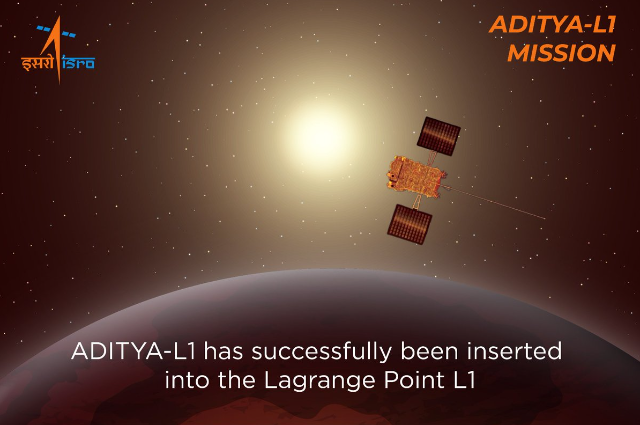Aditya-L1 was launched by ISRO on September 2, 2023, with the mission of observing and helping us better understand the Sun. It arrives at its destination, L1, or the first Sun-Earth Lagrangian point, on January 6.
Here is all you need to know about the mission, from why it is important to why it is placed at the L1 point.
But first, why study the Sun?
The Sun produces energy through nuclear fusion in its interior and emits it from its outer layers. The energy that is produced is equivalent to that released by a nuclear reaction. The photosphere, a 6,000-degree Celsius layer, emits all visible and infrared light, crucial for life. Above is the chromosphere, and higher still is the million-degree Celsius hot corona.
Interestingly, the corona is much hotter than the inner layers of the Sun - there must be some energy source which provides this heat. However, the processes involved in this are not yet fully understood. Moreover, it also emits ultraviolet and X-ray radiation which would be lethal to life on Earth, without the presence of the atmosphere which absorbs most harmful radiation.
What is Solar Wind?
The Sun also continuously streams electrically charged particles — a stream known as the Solar wind. These charged particles produce the spectacular aurorae, known as the Northern and Southern Lights, seen close to the north and south poles of the Earth.
There are also sudden bursts and ejections of charged particles from the Sun into interplanetary space, known as Solar flares and coronal mass ejections. These directly affect space weather, and space-reliant technologies like satellite communication networks, and can produce electric power blackouts in Earth’s higher latitudes. Notably, they can be extremely difficult to predict.
Crucially, this task has to be carried out from outside Earth’s atmosphere, and as close to the Sun as possible. This will then help provide early warning of Solar eruptions, and allow us to initiate actions to minimise the disruption they may cause. It will help us to timely prepare the resilient mechanisms.
Aditya-L1 has seven instruments for the observation of all the radiation and charged particles. Its location, 1.5 million km away from Earth towards the Sun (more on that next), allows uninterrupted observations.
What will Aditya-L1 do?
Since Aditya-L1 is located outside the Earth’s atmosphere, its instruments can observe the ultraviolet radiation from the corona, and in the process, better understand its workings. Moreover, we need to monitor the Solar atmosphere and the corona continuously to monitor eruptions on the Sun and study the properties of charged particles in the Solar wind.
What is L1, the location of Aditya?
L1 stands for the first Lagrangian point — there are five such points, L1 to L5, associated with the motion of one astronomical body around another one, in Aditya’s case, Earth and the Sun. These points were theoretically discovered by the Swiss mathematician Leonhard Euler and the Italian-French mathematician Joseph-Louis Lagrange in the 19th century. We are particularly concerned here with points L1 and L2 because of their relevance to space missions.
When a spacecraft is in orbit around Earth, it is affected by the gravitational force exerted on it by the planet. Yet it does not fall to Earth’s surface because effectively, Earth’s gravity is balanced by a centrifugal force which arises due to the motion of the spacecraft around the Earth.
The Earth’s gravitational pull on a spacecraft gets ever so weaker the further it moves from the planet. Eventually, there comes a point where Earth’s gravitational force becomes comparable to that exerted by the Sun. If a spacecraft moves any further, it will get pulled into orbit around the sun, or eventually crash into it, depending on its speed.
L1 is the sweet spot between Earth and the Sun, where the gravitational force exerted on a spacecraft by the two celestial bodies, and the centrifugal force cancel each other. As a result, once placed exactly at L1, Aditya would always continue to remain there without expending any energy.
The Lagrange Point is a unique region where gravitational forces between the Earth and the Sun reach equilibrium. While absolute neutralization is not achievable due to the influence of other celestial bodies such as the Moon, Mars, and Venus, the L1 point provides a stable position for observational purposes.
Does this mean that Aditya is at a stationary point in space?
L1 is on the line joining the Sun and the Earth. As Earth rotates around the Sun, L1 goes around the Sun too, while always remaining on the same line. Thus, rather than being at the same point in space, Aditya will remain at the same position, relative to the Sun and Earth.
In fact, the L1 point itself is fundamentally unstable — a tiny pull or push can send the spacecraft hurtling away in some other direction. To avoid this, Aditya is placed in an orbit around L1.
And what about L2?
While the L1 is the ideal point to observe the Sun, the L2 is a very useful staging point for spacecraft to be used for observing the distant Universe. L2 also is along the line joining the Sun and Earth, but it is on the opposite side of the Earth, at about 1.5 million kilometers.
So, a spacecraft in a halo orbit around L2 can have all its instruments pointing away from the Earth, to get an uninterrupted view of the deep space. The James Webb Space Telescope (JWST), Gaia, and Euclid are some of the important astronomical probes which are presently in orbit around L2. The Planck mission, which carried out path-breaking observations of the cosmic microwave background radiation was also located there.
. . .
Reference:
- www.isro.gov.in
- indianexpress.com (Experts Explain)
- hindustantimes.com
- timesofindia.indiatimes.com

